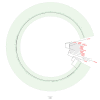Impact of whole genome sequencing on the investigation of food-borne outbreaks of Shiga toxin-producing Escherichia coli serogroup O157:H7, England, 2013 to 2017
- PMID: 30696532
- PMCID: PMC6352002
- DOI: 10.2807/1560-7917.ES.2019.24.4.1800346
Impact of whole genome sequencing on the investigation of food-borne outbreaks of Shiga toxin-producing Escherichia coli serogroup O157:H7, England, 2013 to 2017
Abstract
We aim to provide insight and guidance on the utility of whole genome sequencing (WGS) data for investigating food-borne outbreaks of Shiga toxin-producing Escherichia coli (STEC) O157:H7 in England between 2013 and 2017. Analysis of WGS data delivered an unprecedented level of strain discrimination when compared with multilocus variable number tandem repeat analysis. The robustness of the WGS method ensured confidence in the microbiological identification of linked cases, even when epidemiological links were obscured. There was evidence that phylogeny derived from WGS data can be used to trace the geographical origin of an isolate. Further analysis of the phylogenetic data provided insight on the evolutionary context of emerging pathogenic strains. Publically available WGS data linked to the clinical, epidemiological and environmental context of the sequenced strain has improved trace back investigations during outbreaks. Expanding the use of WGS-based typing analysis globally will ensure the rapid implementation of interventions to protect public health, inform risk assessment and facilitate the management of national and international food-borne outbreaks of STEC O157:H7.
Keywords: EHEC; Escherichia coli O157; United Kingdom; bacterial infections; enterohaemorrhagic E. coli; food-borne infections; gastrointestinal disease; laboratory surveillance; molecular methods; typing; zoonotic infections.
Conflict of interest statement
Figures


Similar articles
-
Whole-genome sequencing for national surveillance of Shiga toxin-producing Escherichia coli O157.Clin Infect Dis. 2015 Aug 1;61(3):305-12. doi: 10.1093/cid/civ318. Epub 2015 Apr 17. Clin Infect Dis. 2015. PMID: 25888672 Free PMC article.
-
Evaluation of whole-genome sequencing for outbreak detection of Verotoxigenic Escherichia coli O157:H7 from the Canadian perspective.BMC Genomics. 2018 Dec 4;19(1):870. doi: 10.1186/s12864-018-5243-3. BMC Genomics. 2018. PMID: 30514209 Free PMC article.
-
Effective Surveillance Using Multilocus Variable-Number Tandem-Repeat Analysis and Whole-Genome Sequencing for Enterohemorrhagic Escherichia coli O157.Appl Environ Microbiol. 2019 Aug 14;85(17):e00728-19. doi: 10.1128/AEM.00728-19. Print 2019 Sep 1. Appl Environ Microbiol. 2019. PMID: 31227555 Free PMC article.
-
Shiga Toxin (Verotoxin)-Producing Escherichia coli in Japan.Microbiol Spectr. 2014 Oct;2(5). doi: 10.1128/microbiolspec.EHEC-0011-2013. Microbiol Spectr. 2014. PMID: 26104366 Review.
-
Characteristics of the Shiga-toxin-producing enteroaggregative Escherichia coli O104:H4 German outbreak strain and of STEC strains isolated in Spain.Int Microbiol. 2011 Sep;14(3):121-41. doi: 10.2436/20.1501.01.142. Int Microbiol. 2011. PMID: 22101411 Review.
Cited by
-
K-mer based prediction of Clostridioides difficile relatedness and ribotypes.Microb Genom. 2022 Apr;8(4):000804. doi: 10.1099/mgen.0.000804. Microb Genom. 2022. PMID: 35384833 Free PMC article.
-
Cross-sectoral genomic surveillance reveals a lack of insight in sources of human infections with Shiga toxin-producing Escherichia coli, the Netherlands, 2017 to 2023.Euro Surveill. 2024 Dec;29(49):2400264. doi: 10.2807/1560-7917.ES.2024.29.49.2400264. Euro Surveill. 2024. PMID: 39639817 Free PMC article.
-
Evidence of on-going transmission of Shiga toxin-producing Escherichia coli O157:H7 following a foodborne outbreak.Epidemiol Infect. 2021 Jun 7;149:e147. doi: 10.1017/S0950268821001278. Epidemiol Infect. 2021. PMID: 34096488 Free PMC article.
-
Foodborne Outbreak of Extended Spectrum Beta-lactamase Producing Shigella sonnei Associated with Contaminated Spring Onions in the United Kingdom.J Food Prot. 2023 Jun;86(6):100074. doi: 10.1016/j.jfp.2023.100074. Epub 2023 Apr 7. J Food Prot. 2023. PMID: 37030629 Free PMC article.
-
Re-analysis of an outbreak of Shiga toxin-producing Escherichia coli O157:H7 associated with raw drinking milk using Nanopore sequencing.Sci Rep. 2024 Mar 9;14(1):5821. doi: 10.1038/s41598-024-54662-0. Sci Rep. 2024. PMID: 38461188 Free PMC article.
References
-
- Wall PG, McDonnell RJ, Adak GK, Cheasty T, Smith HR, Rowe B. General outbreaks of vero cytotoxin producing Escherichia coli O157 in England and Wales from 1992 to 1994. Commun Dis Rep CDR Rev. 1996;6(2):R26-33. - PubMed
-
- Byrne L, Elson R, Dallman TJ, Perry N, Ashton P, Wain J, et al. Evaluating the use of multilocus variable number tandem repeat analysis of Shiga toxin-producing Escherichia coli O157 as a routine public health tool in England. PLoS One. 2014;9(1):e85901. 10.1371/journal.pone.0085901 - DOI - PMC - PubMed
MeSH terms
Substances
LinkOut - more resources
Full Text Sources
Medical
